Venus is colloquially referred to as "Earth's Twin", owing to the similarities it has with our planet. Not surprisingly though, there is a great deal that scientists don't know about Venus. Between the hot and hellish landscape, extremely thick atmosphere, and clouds of sulfuric rain, it is virtually impossible to explore the planet's atmosphere and surface. What's more, Venus' slow rotation makes the study of its "dark side" all the more difficult.
However, these challenges have spawned a number of innovative concepts for exploration. One of these comes from the University of Buffalo's Crashworthiness for Aerospace Structures and Hybrids (CRASH) Laboratory, where researchers are designing a unique concept known as the Bio-inspired Ray for Extreme Environments and Zonal Explorations (BREEZE).
The BREEZE is basically a morphing spacecraft that flaps its wings, similar to how a stingray flaps its pectoral fins, in order to maintain lift in Venus' atmosphere. The concept is one of 12 revolutionary concepts selected by NASA as part of its Innovative Advanced Concepts (NIAC) program - which funds innovative projects that are in early-phase development.
In much the same way that a stingray uses its large fins to swim with ease, the BREEZE's design would make efficient use of the high winds in Venus' upper atmosphere. The craft would circumnavigate the planet every four to six days and would rely on solar panels to recharge its instruments. This would happen every two to three days while the craft is exploring the side of Venus that is illuminated by the Sun.
The BREEZE would take atmospheric samples, track weather patterns, monitor volcanic activity, and gather other data on Venus' environment. Its design would make it especially well-suited for exploring the mysterious dark side of Venus. As Javid Bayandor, an associate professor of mechanical and aerospace engineering and the project's lead investigator, explained it:
"By taking our cues from nature, specifically sea rays, we’re looking to maximize flight efficiency. The design will allow for a so-far unattained degree of control for such a spacecraft that would be subject to severe zonal and meridional winds on the planet."
Venus' dark side remains something of a mystery to scientists because of the way it experiences such long periods of darkness. This is because Venus' rotational period is longer than its orbital period - i.e. it takes slightly more than 243 days to rotate once on its axis and 225 days to complete a single orbit of the Sun. As a result, the time it takes for the Sun to return to the same place in the sky (a solar day) works out to 116.75 Earth days.
The key is the unique design of BREEZE's morphing wings, which will use an internal tensioning system to generate thrust, ensure control and stability, and provide additional lift and mechanical compression. All of this allows for buoyancy control, allowing the BREEZE to navigate through Venus' atmosphere the same way a stingray navigates through water.
This is especially important since it is only above Venus' dense clouds, about 50 km ( mi) above the surface, that temperatures and air pressure are stable enough for an exploration craft to survive. In fact, some scientists have even speculated that it is at these altitudes that life could be found, most likely in the form of extremophile organisms that are capable of living in a hot and acidic environment (aka. thermoacidophilic).
This technology could also enable missions to underwater environments here on Earth and other bodies in the Solar System with dense atmospheres. This is especially true of Titan, Saturn's largest moon and the only other body in the Solar System that has a dense nitrogen-rich atmosphere (roughly 1.45 times as thick as Earth's). Here too, space agencies are looking for long-term missions to explore the exotic environment.
It is also one of many inspired ideas that have been proposed in recent years for exploring Venus' atmosphere. Other concepts like the flying drones being developed by the Boulder-based company Black Swift Technologies (in conjunction with NASA) and the Venus Aerial Mobil Platform (VAMP) that is currently being researched by Northrop Grumman.
The next two decades will be an exciting time for space exploration. Whether its stingray-inspired gliders in the atmosphere of Venus, dragonfly-inspired drones in the skies of Titan, or snake-inspired robots beneath the surface of Mars, there are several proposed missions to explore exotic and mysterious environments. Much of the credit for this will go to designers and engineers who are bringing their outside-the-box thinking to the table.
*Further Reading: University of Buffalo*
 Universe Today
Universe Today



